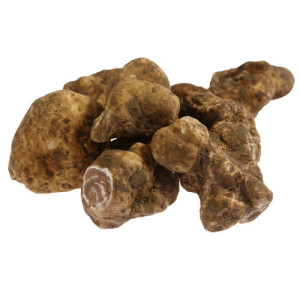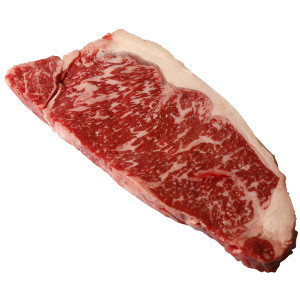“Tell me what you eat, and I will tell you what you are” - Jean Anthelme Brillat-Savarin
The way in which we view and consume food is constantly shifting, many are moving into a 'live to eat' ethos, as opposed to an 'eating to live'. The more food-obsessed among us are always looking for new and interesting ways to add excitement to our mealtimes. We spend hours over hot stoves or peering into glowing ovens, we're always on the hunt for that next big food trend, hoping to be ahead of the curve and part of the foodie movement.
With this in mind, I have compiled a list of some of the most exquisite ingredients that I've had the pleasure of sampling over the last few years. These 'fantastic five' - as I'm coining them henceforth - are not only delicious, but they're fascinating too, because for me, food is about conversation just as much as it is about flavour.
1. Alba White Truffle (Magnatum Pico)
Hailing from the region of Piedmont in Italy, these precious nuggets of deliciousness are typically found growing among oak, hazel, poplar and beech trees. These wild funghi are elusive, even to the most hardy of truffle hunters. Only the most experienced can make a true living out of the truffle hunting game, originally hunters had trained pigs to sniff out these morsels. The problem however, was that the pigs more often than not, would scoff up the truffles before we could get a word in edge ways. In more recent times foragers have opted to train dogs to take on this very important task - thus making a more successful truffle trade for all. These truffles usually have a smooth, yellowish or ochre exterior, and a brown to yellow interior. They boast a distinctly unique and intense flavour that can almost be compared to that of parmesan cheese. They are a jewel in a lot of top chefs' culinary calendars and a must-have for any Italian cuisine enthusiast. It adds a real feeling of celebration to a meal and is a wonderful addition when shaved on to pasta dishes, risottos and soups. I like to shave some on to scrambled eggs every Christmas morning as a tradition, something which my family look forward to every year (sometimes just as much as the turkey dinner).
Related Recipes:
Fine Food Specialist: Truffle Risotto
Fine Food Specialist: Wagyu Ribeye Steak with Truffled Mash
Olive Oil & Lemons: Scrambled Eggs with White Truffle Oil
2. Oca Tuber
Cultivated extensively in Bolivia and Peru, the oca tuber is native to The Andes. Oca has been a staple of rural Andean diets for centuries and is naturally high in vitamin C, potassium, iron and protein. Introduced to the UK in the 1830's, it was known at the time as South American wood sorrel, despite its long-established production, it is not often found in the vegetable aisle of most supermarkets. When it arrived on our shores, the oca tuber caused quite a stir among society, so much so, that food enthusiasts held oca parties where entire meals were constructed around these incredibly interesting tubers. This unusual, yet highly nutritious vegetable, can be used as a substitute for potatoes or carrots in almost any recipe. When eaten raw the oca tuber has a crisp texture and a slightly lemony taste. When cooked, they lose their pinkish-red colouring, and become nuttier and less acidic in flavour. Oca is generally cooked in the same manner as potatoes and is wonderful in soups and stews. The leaves are also edible, great for adding a mild citrus twist to salads.
Related Recipes:
Sunday Hotpants: Butter & Orange Roasted Oca
3. Courgette Flowers
My third ingredient is the edible flower of the courgette plant, fresh courgette flowers are a superb summer treat and can sometimes be found in supermarkets during the summer months, though they often sell-out fast. Courgette Flowers are extremely attractive and bring a superb visual element to a dish. It's typically the male flower that is used for culinary means, but can also be the female (though it has a much shorter shelf life). The flavour is mild and sweet and can be enjoyed raw in salads, though the frilly petals are delicious when stuffed and gently fried. Try filling these beauties with a mix of ricotta, lemon zest and chilli flakes. If you're feeling a bit more adventurous, have a go at piping a smooth scallop mousse into the flower and serve with a salmon fillet, and citrus vinaigrette.
Related Recipes:
Fine Food Specialist: Courgette Ribbon & Ricotta Spaghetti with Lemon Zest
Fine Food Specialist: Courgette Flowers Stuffed with Ricotta, Lemon Zest & Caperberries
4. Black Garlic
Black garlic is a very interesting character within the ingredients arena, popular with chefs and food-enthusiasts alike, over the years it has become one of those ingredients I love to show off to my dinner guests as it always generates a huge amount of intrigue. By ageing fresh garlic bulbs through a controlled heating and moisturising process for several weeks, caramelised black cloves are formed. Black garlic is rich in antioxidants and is often found in a variety of energy drinks. The flavour of black garlic is sweet and syrupy with notes of balsamic vinegar and tangy tamarind. It is delicious cooked in savoury recipes such as a chilli con carne, it has even been known to be used in making a black garlic ice cream (perhaps a bit too exotic for my palette).
Related Recipes:
All Roads Lead to the Kitchen: Black Garlic Chocolate Chunk Ice-Cream
5. Wagyu Beef
Wagyu Beef is the final ingredient in my list of culinary delights and it is the star of the meat world, hailing all the way from Japan, it is by far and wide the best beef I have ever had the pleasure of trying (and I'm quite the beef enthusiast). Wagyu Beef comes from a breed of Japanese cattle (though it is bred elsewhere around the world), I consider it to be the crème de la crème of beef, the caviar of the bovine business. The Japanese wagyu on the Fine Food Specialist website is procured from the Miyaziki region of Japan and is 100% wagyu cattle. It has a bright cherry-red colour, and boasts an intense level of marbling that could rival the marble palace of Kolkata. These generous intramuscular fat deposits are wagyu beef's defining feature, (it's important to point out that the fat found in wagyu is predominantly made up of unsaturated fatty acids which are known to have far fewer negative health effects than that found in standard beef), the melting point of these fats is significantly lower than other meats and occasionally begins to dissolve at room temperature. As the fat melts into the meat during cooking, it imparts a rich, savoury, umami flavour, and the result is wonderfully tender, dissolving on the tongue. This Kobe-style beef will literally turn your taste buds upside down, it can be very rich and a little goes a long way.
Related Recipes:
Fine Food Specialist: Wagyu Beef with Chimchurri Sauce
The Reluctant Housedad: Fillet Steak with Wasabi Butter and Triple-Cooked Chips













